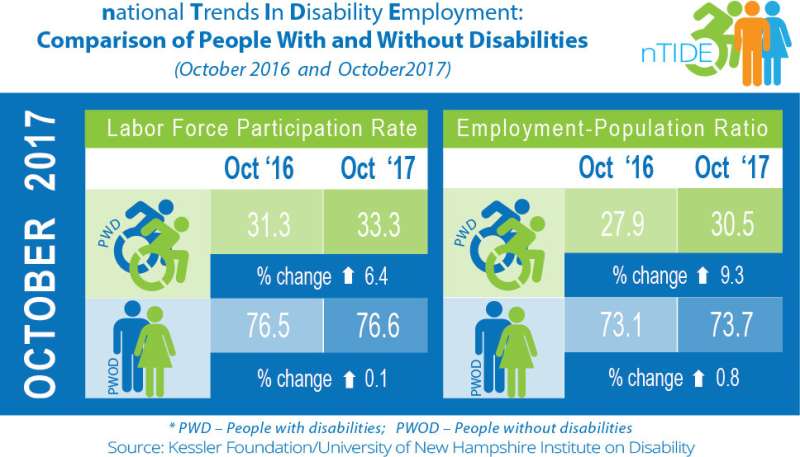Job numbers reflect rising inclusion of Americans with disabilities

The major economic indicators continue to reflect increasing inclusion of Americans with disabilities in the workforce, according to today's National Trends in Disability Employment - Monthly Update (nTIDE), issued by Kessler Foundation and the University of New Hampshire's Institute on Disability (UNH-IOD). Results from a new national survey show that many employers have implemented practices and processes for recruiting, hiring, training, and retaining people with disabilities. The 2017 Kessler Foundation National Employment and Disability Survey: Supervisor Perspectives underscores where success is being achieved and reveals opportunities for maximizing inclusion in the workplace.
In the Bureau of Labor Statistics (BLS) Jobs Report released Friday, November 3 , the employment-to-population ratio for working-age people with disabilities increased from 27.9 percent in October 2016 to 30.5 percent in October 2017 (up 9.3 percent; 2.6 percentage points). For working-age people without disabilities, the employment-to-population ratio also increased from 73.1 percent in October 2016 to 73.7 percent in October 2017 (up 0.8 percent; 0.6 percentage points). The employment-to-population ratio, a key indicator, reflects the percentage of people who are working relative to the total population (the number of people working divided by the number of people in the total population multiplied by 100).
"For the 19th consecutive month, the proportion of people with disabilities working has continued to grow, and once again, their gains are outpacing those of people without disabilities," according to John O'Neill, PhD, director of employment and disability research at Kessler Foundation. "The duration of this upward trend shows that individuals with disabilities are striving to work and that the processes and practices employers are using to recruit and hire people with disabilities appear to be paying off," he added.
The labor force participation rate for working-age people with disabilities increased from 31.3 percent in October 2016 to 33.3 percent in October 2017 (up 6.4 percent; 2 percentage points). For working-age people without disabilities, the labor force participation rate also increased from 76.5 percent in October 2016 to 76.6 percent in October 2017 (up 0.1 percent; 0.1 percentage points). The labor force participation rate is the percentage of the population that is working or actively looking for work.
"Although the job numbers remain positive, we need to remember that people with disabilities have yet to achieve their pre-Great Recession employment levels," said Andrew Houtenville, PhD, associate professor of economics at UNH and research director of the Institute on Disability. "Kessler Foundation's 2017 Survey, by identifying effective practices and processes for inclusion of people with disabilities in the workplace, provides new direction for efforts to narrow the employment gap between people with and without disabilities."
On October 10, 2017, results of the Kessler Foundation National Employment and Disability Survey: Supervisor Perspectives, were released on Capitol Hill. More than 3,000 supervisors responded to the survey, sharing their views about their employers' processes and practices for promoting success in the workplace for employees with and without disabilities. The results indicate how effective each of these processes and practices are for all employees, and provide new information on what works for individuals with disabilities, and where to focus efforts to achieve greater progress.
"Looking at the practices that work for individuals with and without disabilities is especially revealing," noted Dr. O'Neill. "Just as universal design makes spaces usable by all, these practices can make employment more accessible for everyone. Despite being viewed as effective, however, some practices are being underutilized."
For example, only 40% of supervisors had access to training in accessible application and interview techniques, although, in general, they viewed this as very effective and feasible to implement. Similarly, short-term outside assistance was seen as very effective for training of all employees, but used by only 19% of companies. Supervisors reported working from home, flexible scheduling and job sharing as effective accommodations for all employees, but implementation was limited in many companies.
"The survey results provide a new imperative," said Dr. O'Neill. "Better implementation of effective practices is a pathway to greater employment opportunities for individuals with disabilities."




















